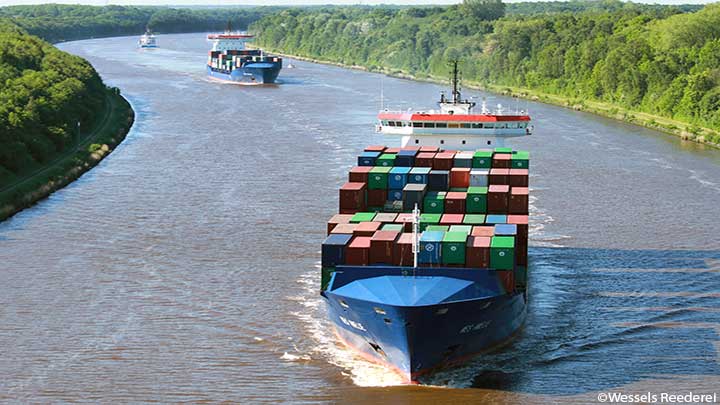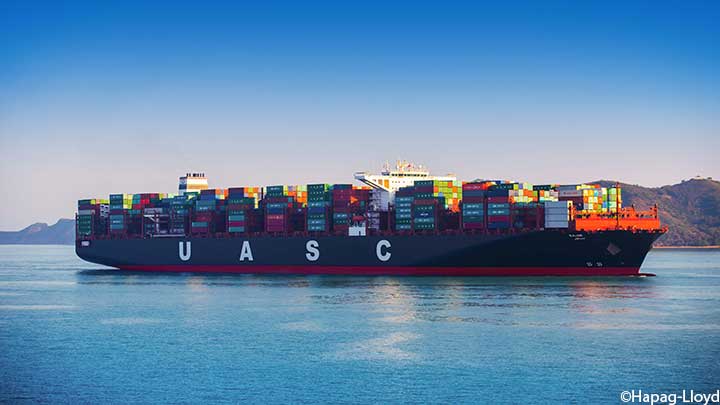Strategies to Meet 2050 Emission Goals in Shipping
To complete the reduction in greenhouse gas emissions in maritime shipping, ship owners, regulatory agencies and builders need to follow multiple tracks to meet 2050 goals. From electric batteries for shoreline activity to a variety of fuels like LNG, methanol, LPG, and ethane as well as alternative fuels like ammonia, synthetic methane, and green hydrogen, maritime energy transition requires more than just one solution, and more than one investor.
By Justin Gerdes

The retrofitted ‘Wes Amelie’, a 1,036-teu feeder container ship, now partially uses liquefied SNG (Synthetic Natural Gas).
January 1, 2020, marked a milestone for the maritime shipping industry. From that date, all shippers were bound by new International Maritime Organization (IMO) rules restricting the use of high-sulfur fuels. The rules are the first of what are likely to be several rounds of regulation to clean up shipping in the coming decades.
Negotiators in Paris deliberately left shipping, which accounts for 2.2% of global CO2 emissions, out of the climate agreement struck in December 2015. Instead, it was left to the IMO to chart the industry’s course towards decarbonization and to compel shipowners to invest in the next generation of low-carbon ships and fuels.
If the maritime sector is to successfully transition to zero-carbon fuels in time to do its part to slow climate change, action must begin today. Ships launched in 2030 will still be at sea in 2050 – when, according to an IMO strategy adopted in April 2018, the sector is to have reduced its total annual greenhouse gas emissions by at least 50 percent.
In the meantime: flexible fuel systems
For shipowners, compliance with the IMO’s low-sulfur fuel rules, while a logistical challenge, was relatively straightforward. With time to prepare, they switched to diesel oil or ultra-low sulfur heavy fuel oil or installed scrubbers to remove emissions at the stack. Decarbonization will be much harder. Shipowners will have to pursue two complementary tracks at once: boosting efficiency to reduce fuel burn and switching to carbon-free fuels, but where to begin?
The first track encompasses solutions like waste heat recovery systems and batteries for hybrid solutions, up-to-date propeller systems and optimized pumps. The second track includes a dizzying menu of options: legacy fossil-based fuels like LNG, methanol, LPG, and ethane as well as alternative fuels like ammonia, synthetic methane, and green hydrogen.
“All of this is starting to be developed and investigated. The industry is seriously looking into all the options. It is hard to say who will win the race,” says Stefan Eefting, Senior Vice President, MAN PrimeServ Augsburg.
The abundance of opportunities comes with a risk. “There’s a bit of uncertainty because everybody realizes the need for change. But it’s also clear that you don’t have one solution,” says Bjarne Foldager, Senior Vice President & Head of Two-Stroke Business, MAN Energy Solutions. “There could be several different solutions, and it might be difficult to assess the risk of where to place your bets.”
“What we are recommending to shipowners,” he adds, “is they need to consider the full fuel flexibility in their decisions. There might not be one solution that will be applicable to the entire life of the ship. Getting the full fuel flexibility is paramount for the shipowner to ensure that his investment is future proof.”
Eefting already sees a potential roadmap: “Right now and medium-term we see LNG as a good fuel to meet environmental standards and to reduce CO2 by up to 20%. We already see an increasing interest in dual fuel engines running on LNG, we’ve sold more than 400 already, but that is still a very low percentage of total shipping worldwide.”
The maritime energy transition will only work out if there is a strong commitment from governments and organizations
“But decarbonization cannot stop with LNG or any other fossile resource and we will not stop either. To reach carbon neutrality we need bigger CO2 reductions. We think the future belongs to synthetic carbon-free fuels generated from renewable energy. On this road LNG is not a dead-end investments, it’s an investment into the future as all such engines can run on carbon-free fuels without further technical adaptions.”
Different low-carbon solutions will be a better fit for different applications, be it near shore or on the open sea. Near-shore ferries and tugboats will be able to transition to battery electric propulsion. For ocean-going container ships and tankers, says Foldager, “electrification could be a good solution in terms of optimizing the fuel efficiency, but it can never be the main propulsion for a big container ship or a big tanker. The energy density in batteries is insufficient.”
Developing carbon-free fuels for the largest ocean-going ships will require the use of incentives and restrictions. Today, alternative fuels – when available – come at a price premium compared to dirtier, carbon-intensive fuels. A price signal established via a global market-based instrument is needed to discourage the use of carbon-based fuels.
“What we need to do is create coalitions globally and get the IMO to support a CO2 tax and then funnel the money into R&D development and into developing solutions for the supply chain and large-scale production of these fuel types,” says Foldager.
We need to get the IMO to support a CO2 tax and then
funnel the money into R&D
Long-term: cooperation and investment by all stakeholders
In December 2019, the International Chamber of Shipping proposed the world’s first collaborative shipping R&D program dedicated to reducing CO2 emissions. The proposal would add a mandatory USD $2 per ton fee to the 250 million tons of marine fuel consumed globally each year. Funds raised – an estimated $5 billion over 10 years – would be deployed with the goal of developing “commercially viable zero-carbon emission ships by the early 2030s.”
It’s a start but pales compared to what is required to solve the problem. A study commissioned by the Getting to Zero Coalition published on January 2020 found that the shipping industry must invest up to $70 billion annually between 2030 and 2050 to meet the IMO’s 2050 emissions reduction target.

The 15,000 TEU container vessel Sajir, owned by Hapag-Lloyd, is undergoing a conversion to dual-fuel operation.
“The maritime energy transition will only work out if there is also a strong commitment from governments and officials and organizations to make us move further in the right direction,” says Stefan Eefting. “Shippers by tradition will only think about putting something like that into place, and invest into, it if it is demanded by the IMO,” he adds.
It’s the job and responsibility of the regulating body to ensure a level playing field for all market participants. But an industry as global as the marine industry can only be regulated on a global scale. All other approaches would lead to a dangerous patchwork of regulations and undermine the effectiveness of the measures to reduce emissions.
The IMO must force laggards to keep up with shipowners who are committed to climate action. If the industry is to have any chance to meet its long-term decarbonization targets, much more aggressive mandatory rules are needed! Baby steps, such as the Energy Efficiency Design Index for new ships adopted by the IMO nearly a decade ago, are not sufficient to put the industry on a course to slash emissions on the scale demanded by science.
About the author
Justin Gerdes is a San Francisco Bay Area-based independent journalist specializing in energy issues.
Explore more topics
MAN Energy Solutions is now Everllence.
We have adopted a new brand name and moved to a new domain: www.everllence.com. This page will also be relocated there shortly. We are working on shifting all pages to www.everllence.com.
